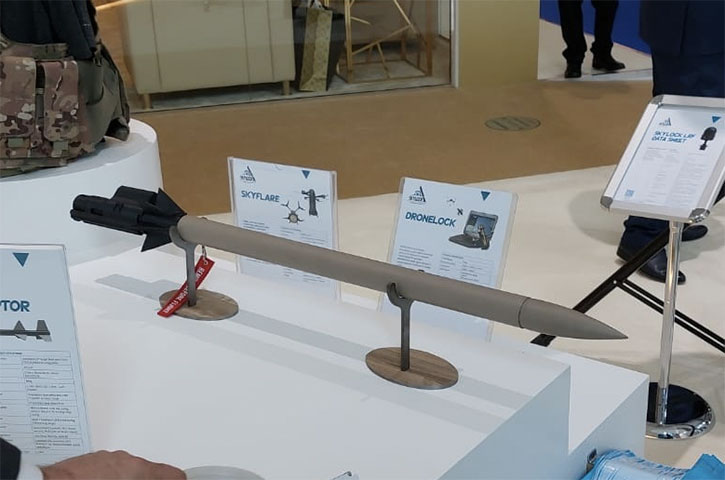With the growing risk of drone attacks, military and law enforcement forces seek effective means of defeating unmanned aerial vehicles. Of particular concern are the multirotor platforms that pose severe threats to civilians, strategic facilities, and military forces. [playht_player width=”100%” height=”90px” voice=”en-US-JennyNeural”]
The drones based on commercial and Do-It-Yourself (DIY) kits can be detected, intercepted, and defeated by electronic means (GPS and control link jamming, electronic ‘hijacking’ etc.). Still, others modified to become resistant to jamming and hacking. Hard kill measures are necessary to deal with these targets. Such do not necessarily rely on firearms or high directed energy, and they can employ other means to eliminate the threat before the drones reach their destination.
Israel’s C-UAS expert Skylock has unveiled at the UMEX exhibition in Dubai this week a new rocket-shaped drone inhibitor countermeasure called Sky Interceptor. According to the manufacturer, the rocket is already in production, with more than 1,000 units produced and delivered. Unlike other hard-kill countermeasures that rely on explosives and firearms and are therefore subject to export control, Sky Interceptor is commercially available and is not subject to ITAR restrictions.
Sky Interceptor is based on patent-pending technologies that enable tracking and kinetic mitigation of small UAS using a persistent countermeasure cloud released by the rocket. The cloud improves the ability to defeat small UAS at relatively long distances (compared to other non-lethal hard-kill measures) by arresting their propellers and disabling their propulsion system.

The countermeasure weighs 880 grams and measures 895 mm in length. Two versions are offered, a basic version with 40mm diameter and a range of 1,100 m’ and an extended range rocket with a small booster with a 50 mm diameter, extending to 3 km. The countermeasure can be launched from the ground or the air, by helicopters or other drones, and uses a small solid rocket to reach its target.
According to Skylock, the system is safe to operate in an urban environment and enables security forces to engage UAS at a longer range without the risk of collateral damage. The warhead packs a condensed mesh of thin rubber stripes that entangles the drone’s propellers to disable its propulsion, causing it to crash. The stripes cloud deployed by the interceptor scatters over a wide area and enables the system to engage drones even as they perform evasive maneuvers and against drone swarms.
Compared to other rotor-arrestor drone countermeasures, such as net guns and 40mm grenades deploying rubber stripes, having a larger container and rocket propulsion provides Sky Interceptor with a longer range and larger area coverage, comparable to much more expensive kinetic weapons, such as C-UAS missiles, and airburst projectiles. The rockets are also cheaper to procure and maintain; according to Skylock (which produces the rockets and jammers), Sky Interceptor is more cost-effective than kinetic or electronic countermeasures.























